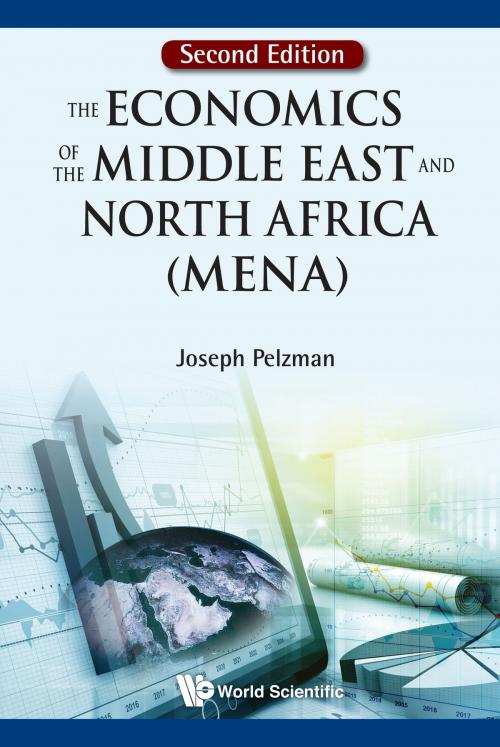The Economics of the Middle East and North Africa (MENA)
Business & Finance, Economics, International Economics, Economic Development| Author: | Joseph Pelzman | ISBN: | 9789813203990 |
| Publisher: | World Scientific Publishing Company | Publication: | November 29, 2018 |
| Imprint: | WSPC | Language: | English |
| Author: | Joseph Pelzman |
| ISBN: | 9789813203990 |
| Publisher: | World Scientific Publishing Company |
| Publication: | November 29, 2018 |
| Imprint: | WSPC |
| Language: | English |
The Middle East and North Africa (MENA) is a large, complex, and diverse region, which faces a wide range of economic issues. The MENA group includes Algeria, Bahrain, Cyprus, Djibouti, Egypt, Iran, Iraq, Israel, Jordan, Kuwait, Lebanon, Libya, Morocco, Oman, Qatar, Saudi Arabia, Syria, Tunisia, Turkey, United Arab Emirates, and Yemen.
The purpose of this book is not to provide a country-by-country study, but rather to deal with general economic themes found in Arab MENA and Israel, such as problems associated with growth and structural change; the role of State-intervention in country-specific local markets; labor market imperfections driven by gender bias; technology gaps and endogenous growth; capital market development in a restricted financial model based on religious constraints; savings and investment behaviour in a model of state subsidization and intervention designed to control local development; and the role of the state in constraining private sector activity. Data sources used in this second edition include country-specific data, the World Bank, the United Nations, the International Monetary Fund and the Organisation for Economic Co-operation and Development.
The new material in this second edition includes a discussion of the impending and inevitable leadership changes which will occur throughout Arab MENA over the next decades. The evidence to support this evaluation is based on the current lack of transparent markets; the lack of inclusive macro policies, the impact of distortionary micro economic policies across all sectors; and the impact of anti-globalization and xenophobia on innovation. Old chapters are revised with updated data, a discussion of the role of the 'State' and 'Oligarchies' in the economies of most of the MENA countries, an in-depth exploration of the investment in human capital and growth and an identification of the most important binding constraints to economic development in Arab MENA and Israel.
This book serves as both a textbook and a summary of the very large literature on MENA. It examines the economic realities of the region and compares them across the MENA economies. It should be stressed that this book is not about the latest political debate on who did what to whom in the Middle East or in North Africa. The focus is on economics, not political economics.
Contents:
- Introduction
- Survey of Main Economic Outcomes
- Islamic Economics: The Role of Interest-Free Finance in MENA's Development
- Investment in Human Capital
- Labor Market in MENA
- Oil Money and the 'Dutch Disease'
- Science, Technology and Innovation in MENA
- International Trade in MENA
- Conclusions and Prospects for MENA
Readership: Economics and Finance, Development Economics, International Economics, International Finance, Investment and Finance, Markets and Institutions.
Key Features:
- There are no economic textbooks covering this material. This textbook will have no or limited competition
- This book presents a unique approach to discuss the MENA economies. It focuses on specific development issues and examines how it applies to the individual countries. In effect, the basis for comparison will be an economic construct. This avoids biased comparison of one country's performance to another
- The analysis presented in this volume is based on mainstream economic analysis found in the development and growth literature
The Middle East and North Africa (MENA) is a large, complex, and diverse region, which faces a wide range of economic issues. The MENA group includes Algeria, Bahrain, Cyprus, Djibouti, Egypt, Iran, Iraq, Israel, Jordan, Kuwait, Lebanon, Libya, Morocco, Oman, Qatar, Saudi Arabia, Syria, Tunisia, Turkey, United Arab Emirates, and Yemen.
The purpose of this book is not to provide a country-by-country study, but rather to deal with general economic themes found in Arab MENA and Israel, such as problems associated with growth and structural change; the role of State-intervention in country-specific local markets; labor market imperfections driven by gender bias; technology gaps and endogenous growth; capital market development in a restricted financial model based on religious constraints; savings and investment behaviour in a model of state subsidization and intervention designed to control local development; and the role of the state in constraining private sector activity. Data sources used in this second edition include country-specific data, the World Bank, the United Nations, the International Monetary Fund and the Organisation for Economic Co-operation and Development.
The new material in this second edition includes a discussion of the impending and inevitable leadership changes which will occur throughout Arab MENA over the next decades. The evidence to support this evaluation is based on the current lack of transparent markets; the lack of inclusive macro policies, the impact of distortionary micro economic policies across all sectors; and the impact of anti-globalization and xenophobia on innovation. Old chapters are revised with updated data, a discussion of the role of the 'State' and 'Oligarchies' in the economies of most of the MENA countries, an in-depth exploration of the investment in human capital and growth and an identification of the most important binding constraints to economic development in Arab MENA and Israel.
This book serves as both a textbook and a summary of the very large literature on MENA. It examines the economic realities of the region and compares them across the MENA economies. It should be stressed that this book is not about the latest political debate on who did what to whom in the Middle East or in North Africa. The focus is on economics, not political economics.
Contents:
- Introduction
- Survey of Main Economic Outcomes
- Islamic Economics: The Role of Interest-Free Finance in MENA's Development
- Investment in Human Capital
- Labor Market in MENA
- Oil Money and the 'Dutch Disease'
- Science, Technology and Innovation in MENA
- International Trade in MENA
- Conclusions and Prospects for MENA
Readership: Economics and Finance, Development Economics, International Economics, International Finance, Investment and Finance, Markets and Institutions.
Key Features:
- There are no economic textbooks covering this material. This textbook will have no or limited competition
- This book presents a unique approach to discuss the MENA economies. It focuses on specific development issues and examines how it applies to the individual countries. In effect, the basis for comparison will be an economic construct. This avoids biased comparison of one country's performance to another
- The analysis presented in this volume is based on mainstream economic analysis found in the development and growth literature















